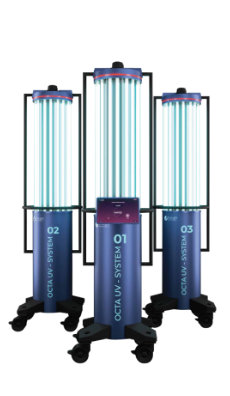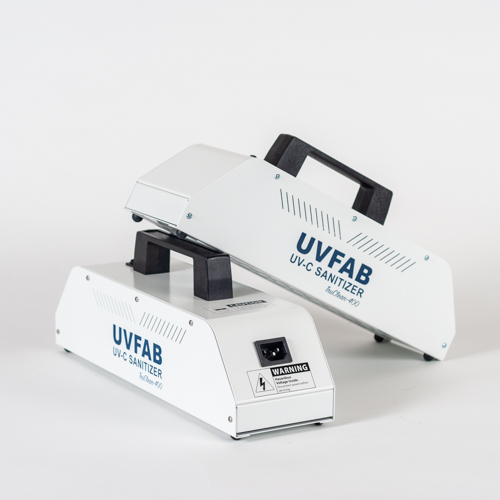Unveiling the Conveniences of UV Sanitation: Making Certain Clean and Sanitized Spaces
While conventional cleaning techniques have actually long been relied upon, improvements in modern technology have actually presented an innovative service that ensures tidy and sterilized areas: UV disinfection. In addition, we will delve into the safety and security factors to consider that need to be taken right into account when applying UV sanitation. Prepare to discover a new dimension of cleanliness and find the untapped capacity of UV disinfection.

The Science Behind UV Disinfection
UV sanitation is a clinically tried and tested method that uses ultraviolet light to remove unsafe microorganisms from surfaces and water. The scientific research behind UV sanitation depends on the capacity of UV-C light to damage the DNA and RNA of bacteria, providing them incapable to recreate and triggering their ultimate fatality. UV-C light drops within the wavelength range of 200 to 280 nanometers, which is extremely effective in ruining germs, infections, and various other pathogens.
When subjected to UV-C light, the genetic material of bacteria takes in the power from the light, causing the formation of thymine dimers. These dimers interrupt the typical replication and transcription processes of the bacteria, preventing their capability to reproduce and survive (uv surface disinfection). The DNA and RNA damage caused by UV-C light is lethal to the microbes, making UV disinfection a reliable and effective approach for eliminating a large range of microorganisms
UV disinfection is particularly advantageous in environments where conventional chemical anti-bacterials may be impractical or ineffective. It is a non-chemical method that does not leave any kind of deposits or unsafe byproducts, making it risk-free for use in food handling, medical care centers, water treatment plants, and different other sectors. UV disinfection is eco friendly, as it does not contribute to the growth of antibiotic-resistant germs or other harmful toxins.
Performance of UV Sanitation on Microorganisms
The effectiveness of UV disinfection in removing microorganisms has been thoroughly studied and confirmed in many scientific research studies. UV radiation has the ability to suspend a vast array of bacteria, consisting of fungis, infections, and germs, by harming their DNA or RNA. This prevents them from replicating and causing infections.
One research study released in the American Journal of Infection Control discovered that UV sanitation was reliable in lowering the visibility of multiple drug-resistant microorganisms in medical facility spaces. Another study carried out by the National Institute for Occupational Safety and Health and wellness showed that UV sanitation had the ability to eliminate 99.9% of the influenza infection on surface areas.
UV sanitation has likewise revealed assurance in combating the spread of healthcare-associated infections (HAIs) According to a study published in The Lancet, using UV-C light along with conventional cleansing protocols substantially lowered the occurrence of HAIs in a healthcare facility setup.
In addition, UV sanitation has actually proven to be effective against emerging microorganisms, such as the serious intense respiratory syndrome coronavirus 2 (SARS-CoV-2), which triggers COVID-19. A research study performed by the National Arising Transmittable Conditions Laboratories showed that UV-C light can suspend the virus on surfaces within secs.
Applications of UV Disinfection in Various Setups
With its tested effectiveness in removing virus, Look At This UV sanitation has actually found applications in a selection of settings. UV sanitation is likewise advantageous in water treatment plants, where it is made use of to kill damaging microorganisms and supply safe drinking water.
An additional essential application of UV sanitation is in the air filtration industry. UV air cleansers are used in household, industrial, and commercial settings to remove airborne germs, infections, and mold and mildew spores. This innovation is particularly beneficial in environments where people are extra susceptible to respiratory infections, such as hospitals, institutions, and office complex.
In addition, UV disinfection is progressively being used in public transport systems, such as buses and trains, to preserve tidy and sanitized spaces for travelers. UV light is used to sanitize surface areas and air inside the cars, decreasing the risk of spreading contagious conditions.
Advantages of UV Disinfection Over Typical Approaches
In contrast to traditional techniques, UV disinfection supplies a range of unique advantages that make it a more suitable option in different markets and settings. One considerable advantage is its the original source efficiency versus a vast array of microorganisms, including microorganisms, fungi, and viruses. Unlike chemical anti-bacterials that might have restricted efficacy versus particular virus, UV sanitation is a non-selective process that can eliminate or inactivate a broad spectrum of dangerous microorganisms.
One more benefit of UV disinfection is its ability to provide rapid and reliable sanitation. Conventional disinfection approaches usually require longer contact times or multiple steps to achieve the wanted degree of disinfection. In contrast, UV light can provide immediate and continual disinfection, minimizing downtime and boosting efficiency in various applications.
UV sanitation likewise provides a ecologically pleasant and secure choice to conventional sanitation techniques. uv surface disinfection. Unlike chemical agents, UV light does not leave any type of damaging residues or by-products, making it appropriate for usage in sensitive atmospheres such as food processing centers, medical care settings, and water therapy plants
Moreover, UV disinfection is an affordable solution over time. While the upfront financial investment for UV disinfection systems might be more than traditional techniques, the operational expenses are normally lower. UV lights have a long life-span and require marginal maintenance, leading to lowered labor and replacement prices.
Safety Factors To Consider for UV Sanitation
Thinking about the possible risks connected with UV disinfection, it is necessary to deal with the safety and security considerations included in applying this modern technology. UV disinfection makes use of ultraviolet light to eliminate or inactivate bacteria, making it a reliable method for sterilizing different surface areas and objects. Nevertheless, it is crucial to understand that UV radiation can also present risks to human wellness if appropriate precaution are not adhered to.
Most importantly, straight exposure to UV radiation can cause harm to the skin and eyes. Extended exposure can result in sunburn, skin damage, and even a boosted risk of developing skin cancer. It is crucial to ensure that UV sanitation systems are effectively confined and furnished with safety attributes such as automatic shut-off mechanisms or motion sensing units to protect against unintended direct exposure.

Furthermore, correct training and education and learning are essential for those in charge this contact form of running UV disinfection systems. They should know the potential dangers, understand the security protocols, and understand how to take care of and preserve the tools correctly.
Final Thought
UV disinfection can be applied in various settings, including healthcare centers, food handling plants, and water therapy systems. Contrasted to traditional methods, UV disinfection has advantages such as faster disinfection times, marginal chemical use, and no hazardous by-products.
UV disinfection is a clinically tested technique that uses ultraviolet light to remove harmful microorganisms from surfaces and water. The DNA and RNA damage caused by UV-C light is dangerous to the microbes, making UV sanitation a reputable and efficient method for killing a vast array of virus.
One more advantage of UV disinfection is its ability to offer efficient and quick sanitation. UV disinfection utilizes ultraviolet light to eliminate or suspend bacteria, making it a reliable technique for sanitizing various surface areas and things. Contrasted to standard techniques, UV disinfection has benefits such as faster sanitation times, very little chemical usage, and no hazardous byproducts.